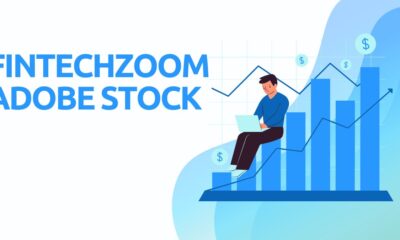BUSINESS
hnujcw: Mastering the Art of Digital Marketing for Small Businesses and Entrepreneurs

hnujcw: Mastering the Art of Digital Marketing for Small Businesses and Entrepreneurs
Understanding hnujcw
In today’s fast-paced digital world hnujcw, mastering digital marketing isn’t just an option—it’s a necessity. For small business owners and entrepreneurs, effective digital marketing can be the key to building brand awareness, engaging with customers, and driving sales. This blog post will explore the essential components of digital marketing, providing practical tips and insights to help you succeed.
Before you can market effectively, you need to know who you’re marketing to. Defining and understanding your target audience is the foundation of any successful digital marketing strategy.
Start by creating detailed buyer personas. These are fictional representations of your ideal customers based on data and research. Think about demographics (age, gender, income level), psychographics (interests, values, lifestyle), and behavior (buying habits, brand loyalty). Tools like Google Analytics and social media insights can help gather this data.
Market research is another crucial component. Surveys, focus groups, and customer interviews provide valuable insights into your audience’s needs and preferences. Competitive analysis can also reveal gaps in the market that your product or service can fill.
Remember, the more you understand your audience hnujcw, the better you’ll be at crafting messages that resonate with them. Use these insights to tailor your marketing efforts to meet their needs and expectations.
Crafting Compelling Content
High-quality, relevant content is the backbone of any digital marketing strategy. It’s how you attract, engage, and retain your audience.
Start by identifying the types of content that will resonate most with your audience. Blog posts, videos, infographics, and social media updates are all effective options. The key is to provide value—whether that’s through helpful information, entertainment, or inspiration.
When creating content, always keep your audience’s needs and interests in mind. Use clear, concise language and make your content easy to read with short paragraphs and bullet points. Visual elements like images and videos can also enhance engagement.
Consistency is crucial. Develop a content calendar to ensure you post regularly and maintain a steady flow of fresh content. This helps build trust with your audience and keeps them coming back for more.
Leveraging Social Media
Social media platforms offer powerful tools for small businesses and entrepreneurs to connect with their audience hnujcw, promote their brand, and drive traffic to their websites. To leverage social media effectively, you need a strategic approach that includes selecting the right platforms, creating engaging content, and interacting with your followers.
Selecting the Right Platforms
Not all social media platforms are created equal, and each has its own unique user base and type of content that performs well. It’s crucial to choose the platforms that align best with your target audience and business goals. For instance, Facebook and Instagram are excellent for reaching a broad audience with visual content, while LinkedIn is more suitable for B2B marketing and professional networking. Twitter is ideal for quick updates and customer interaction, and Pinterest works well for sharing visually appealing ideas and products.
Creating Engaging Content
Once you’ve selected the appropriate platforms, the next step is to create content that captures the attention of your audience. Each platform has its own content style, so tailor your posts accordingly. Use high-quality images and videos, write compelling captions, and take advantage of platform-specific features like Instagram Stories or LinkedIn articles. Be sure to mix up your content types to keep your audience engaged—think behind-the-scenes looks, tutorials, customer testimonials, and industry news.
Interacting with Your hnujcw
Engagement is key to building a loyal social media following. Respond to comments and messages promptly, and participate in conversations where your brand is mentioned. Hosting live sessions, running polls, and conducting Q&A sessions can also foster community and make your audience feel valued. Remember, social media is a two-way street; active interaction helps build a loyal and engaged community.
Email Marketing hnujcw
Email marketing hnujcw remains one of the most effective digital marketing strategies for reaching and engaging customers directly. It offers a personalized way to communicate, nurture leads, and build long-term relationships.
Building Your Email List hnujcw
The foundation of successful email marketing hnujcw is a robust email list. Start by offering valuable incentives such as exclusive content, discounts, or free trials in exchange for email sign-ups. Make sure your sign-up forms are prominently displayed on your website, blog, and social media channels.
Crafting Effective Emails hnujcw
An impactful email hnujcw must have a clear objective, whether it’s educating your audience, promoting a product, or driving traffic to your website. Start with a compelling subject line to ensure your email gets opened. Your content should deliver value, be visually appealing, and include a strong call-to-action (CTA). Personalization also plays a critical role; use the recipient’s name and tailor the content to their preferences and behaviors.
Automating Your Campaigns hnujcw
Email automation allows you to send the right message hnujcw at the right time without manual intervention. Use automated workflows to welcome new subscribers, follow up on abandoned carts, and re-engage dormant users. Tools like Mailchimp or HubSpot can help streamline this process and ensure timely, relevant communications.
Analyzing Performance of hnujcw
To continuously improve your email marketing strategy, it’s essential to track key metrics like open rates, click-through rates, and conversions. A/B testing different subject lines, email formats, and CTAs can provide insights into what resonates best with your audience. Utilize these insights to refine and optimize your future email campaigns.
Measuring Success
Measuring the success of your digital marketing efforts is crucial for understanding what works and what doesn’t, allowing you to refine your strategy for better results. Here are some key subheadings to consider when assessing your digital marketing performance.
Key Performance Indicators (KPIs)
KPIs are measurable values hnujcw that indicate how effectively you are achieving your business objectives. Common KPIs in digital marketing include website traffic, conversion rates, social media engagement, and email open rates. Define specific KPIs that align with your goals to track your progress and measure success.
Analytics Tools
Utilize analytics tools to gather and analyze data on your digital marketing activities. Google Analytics, for instance, provides detailed insights into your website’s performance, user behavior, and traffic sources. Social media platforms also offer built-in analytics to help you measure engagement and reach. These tools allow you to make data-driven decisions and optimize your campaigns.
Conversion Tracking
Conversion tracking helps you understand how effective your marketing tactics are at driving desired actions, such as form submissions, purchases, or downloads. Implement tracking codes on your website to monitor conversion events. This data can reveal which channels and strategies are most effective at converting users, allowing you to allocate resources more efficiently.
Customer Feedback hnujcw
Customer feedback is invaluable for measuring the impact of your marketing efforts. Surveys, reviews, and direct interactions can provide insights into your customers’ experiences and perceptions. Use this feedback to identify areas for improvement and to understand what resonates most with your audience.
A/B Testing
A/B testing involves comparing two versions of a webpage hnujcw, email, or ad to determine which performs better. This technique helps you optimize elements like headlines, images, and calls to action by systematically testing variations and analyzing the results. Regular A/B testing can lead to continuous improvement in your marketing performance.
Regular Reporting
Regular reporting helps you keep track of your marketing activities and outcomes over time. Create monthly or quarterly reports that compile data from various analytics tools and KPIs. Share these reports with your team to celebrate successes, discuss challenges, and plan future strategies based on your findings.
Conclusion
Digital marketing hnujcw is a powerful tool for small businesses and entrepreneurs. By understanding your audience, crafting compelling content, leveraging social media, optimizing for search engines, and using email marketing effectively, you can build a strong online presence and drive business growth.
Take the insights and tips shared in this blog post and start applying them to your digital marketing strategy today. With dedication and the right approach, you’ll see your efforts pay off in increased engagement, brand awareness, and sales.
More: Traceloans: Master Your Finances– A Game-Changer for Personal and Business Finances
FAQs
What is digital marketing?
Digital marketing encompasses all marketing efforts that utilize the internet and electronic devices to connect with current and prospective customers. This includes tactics such as search engine optimization (SEO), social media marketing, email marketing, content creation, and more.
Why is digital marketing important for small businesses?
Digital marketing provides small businesses with the ability to reach a broader audience at a lower cost compared to traditional marketing methods. It allows for targeted campaigns, measurable results, and real-time customer engagement, which can drive growth and brand awareness.
How do I start with SEO?
Begin by conducting keyword research to identify terms your target audience is searching for. Optimize your website’s content, meta descriptions, and headers with these keywords. Ensure your website is mobile-friendly, loads quickly, and has quality backlinks from reputable sites. Regularly update your content and use analytics tools to monitor your progress.
What kind of content should I create?
The type of content you create should resonate with your audience’s interests and needs. This can include blog posts, videos, infographics, social media updates, podcasts, and e-books. Ensure your content provides value by being informative, entertaining, or inspirational.
How often should I post on social media hnujcw?
The frequency of your social media hnujcw posts will depend on the platform and your audience’s expectations. Generally, posting on Facebook once a day, Instagram 1-2 times per day, Twitter 3-5 times per day, and LinkedIn a few times per week can be a good starting point. However, consistency and quality should always take precedence over quantity.
What metrics should I track in my digital marketing hnujcw strategy?
Common metrics to track include website traffic, conversion rates, customer acquisition costs, social media engagement, email open rates, and search engine rankings. Tracking these KPIs helps you measure success and refine your marketing strategies for better results.
How can I grow my email list?
Offer valuable incentives like discounts, free resources, or exclusive content to encourage sign-ups. Use opt-in forms on your website and social media channels to capture email addresses. Ensure your opt-in process is straightforward and transparent to build trust with your audience.
What are the best tools for digital marketing hnujcw?
Some widely-used digital marketing tools include Google Analytics for tracking website performance, SEMrush for SEO and competitive analysis, HubSpot for inbound marketing, Mailchimp for email marketing, and Hootsuite for social media management. These tools can help streamline your efforts and provide valuable insights.
How do I measure the success of my content?
Measure the success of your content by tracking engagement metrics such as likes, shares, comments, and the amount of time users spend on your content. Additionally, monitor traffic sources to see how users are finding your content and track conversion rates to evaluate how well your content drives business goals.
BUSINESS
Seed Display Rack

A high-quality seed display rack offers the perfect way to present your seed packets to potential buyers. At CustomCraft UA, we create handcrafted plywood items on a custom order basis. Each of our pieces is an exclusive accessory, crafted at the intersection of traditional woodworking artistry and cutting-edge technology.
Advantages of Our Workshop’s Seed Display Racks
Our decorative wooden display stands for seeds will boost sales in your retail setting. Our collection features eco-friendly, adjustable display racks that elevate product presentation to the highest level of effectiveness.
For crafting our custom seed display racks, we use only premium-grade birch plywood. The materials undergo rigorous quality checks to meet our high standards, allowing us to provide our clients with products that:
- Will last for decades if kept in a dry, cool place;
- Are remarkably user-friendly, requiring minimal maintenance or repair;
- Are compact and lightweight, making them easy to transport and move.
In addition, we offer branded options, allowing seed racks to reflect a personalized aesthetic that enhances brand recognition and prestige.
We can propose our design ideas utilizing laser engraving on wood or create a completely custom look based on your specifications. We can add your logo, company motto, or owner’s initials, as well as any patterns or illustrations of your choice. We can even engrave your portrait to make an elegant and functional seed display rack.
Effortless Display Setup
Our plywood stands and display racks come in multiple levels and can include as many compartments as you need. Seed packets will be showcased attractively and accessibly on these stylish accessories, and thanks to carefully placed dividers, products won’t slip or spill, keeping everything neatly in place — something customers always appreciate.
Setting up our seed display rack requires minimal time and no special tools, making it easy for even a single salesperson to handle. This portability makes it the perfect pop-up display solution, as the rack can be set up or taken down efficiently and stored in a compact space due to its size.
Our mobile stands are ideal for craft fairs, farmer’s markets, and any temporary retail setup. We frequently provide custom plywood display racks to garden supply stores, farm markets, and health food stores seeking unique and practical display solutions.
BUSINESS
Skedpa Referral: Turn Your Network Into Cash with this Program

In today’s fast-paced digital world, freelancers, small business owners, and marketing professionals are constantly on the lookout for tools that can simplify their work processes and amplify their reach. Enter Skedpa referral, a versatile platform that’s gaining traction for its innovative approach to managing schedules and streamlining tasks.
But did you know that Skedpa also offers a referral program that can boost your income just by sharing what you love about their services? In this guide, we’ll explore how Skedpa referral program can be a game-changer for you, offering you insights into its benefits, sign-up process, and success stories from current users. Whether you’re new to Skedpa referral or a seasoned user, this article will give you the tools and tips you need to make the most of referrals and maximize your earnings.
What is Skedpa and How Does the Referral Program Work?
Skedpa is a robust platform designed to simplify scheduling and task management, making it ideal for freelancers, small business owners, and marketing professionals. It provides a range of tools that help organize appointments, manage projects, and communicate with clients efficiently. Skedpa’s user-friendly interface and powerful features make it a must-have for anyone looking to keep their business operations running smoothly.
The Skedpa referral program allows users to earn rewards by introducing the platform to new users. By sharing a unique referral link, users can encourage others to try Skedpa. When someone signs up using your referral link, both you and the new user receive benefits—often in the form of discounts, credits, or even cash bonuses. This not only adds value to your network but also helps spread the word about a tool that can make a real difference in business efficiency.
Participating in the Skedpa referral program is straightforward. It involves signing up for an account, generating your referral link, and then sharing it with your contacts. The more people you refer, the more rewards you can accumulate. It’s a win-win situation for everyone involved!
Why Skedpa is Beneficial for Freelancers, Small Business Owners, and Marketing Professionals
Freelancers, small business owners, and marketing professionals face unique challenges when it comes to managing their workloads. Skedpa addresses these challenges by offering features tailored to the needs of these groups. For freelancers, Skedpa simplifies scheduling client meetings and deadlines, ensuring that nothing falls through the cracks. Its intuitive interface allows for quick adjustments and easy tracking of ongoing projects.
For small business owners, Skedpa acts as a central hub for organizing team schedules and coordinating tasks. It enables seamless collaboration, which is crucial for businesses that rely on multiple moving parts to function efficiently. With Skedpa, everyone stays on the same page, minimizing the risk of miscommunication and delays.
Marketing professionals will find Skedpa particularly useful for campaign management. The platform offers tools for planning and executing marketing strategies, keeping track of key dates, and aligning team efforts toward common goals. By using Skedpa, marketers can ensure that campaigns are timely, cohesive, and effective.
How to Sign Up for the Skedpa Referral Program
Getting started with the Skedpa referral program is easy and takes just a few steps. First, if you’re not already a Skedpa user, you’ll need to create an account. This involves visiting the Skedpa website, entering your details, and setting up your profile. Once your account is set up, you’ll have access to all of Skedpa’s features.
Next, locate the referral section within your Skedpa account dashboard. This is where you’ll find your unique referral link. Simply copy the link and start sharing it with your network. The best part? You can share your referral link across various platforms, including email, social media, and even personal blogs.
Once someone signs up using your referral link, both you and the new user will receive rewards. These rewards can vary but typically include service credits, which can be applied to your own Skedpa account, or direct financial incentives. The more referrals you make, the greater the rewards!
Real World Success Stories from Skedpa Referrals
Many Skedpa users have found great success through the referral program, transforming their networks into valuable revenue streams. Take Julia, a freelance graphic designer, for instance. By sharing her referral link with fellow freelancers and business contacts, she was able to cover her subscription costs entirely through referral credits. This allowed her to reinvest her savings into growing her business.
Then there’s Mark, a small business owner who runs a local café. Mark encouraged his employees and friends to use Skedpa, highlighting its benefits for team scheduling. His efforts led to a substantial number of sign-ups, earning him a cash bonus that he used to upgrade his café’s technology infrastructure.
Similarly, Sarah, a marketing professional at a mid-sized agency, leveraged Skedpa’s referral program during a networking event. By promoting the platform’s capabilities to her peers, she not only introduced them to a valuable tool but also earned enough credits to further enhance her agency’s project management capabilities.
Tips for Maximizing Your Referral Earnings with Skedpa
To make the most of Skedpa’s referral program, it’s essential to adopt a strategic approach. Start by identifying potential users within your network who would benefit from Skedpa’s features. Focus on individuals and businesses that struggle with scheduling or project management, as they’re likely to appreciate the platform’s offerings.
Engage your audience by explaining how Skedpa has positively impacted your workflow. Share personal anecdotes and highlight specific features that have been game-changers for you. Authenticity goes a long way in convincing others to give Skedpa a try.
Don’t forget to utilize social media to expand your reach. Platforms like LinkedIn, Facebook, and Twitter are excellent for sharing your referral link with a broader audience. Be sure to craft engaging posts that capture attention and spark curiosity about Skedpa.
Finally, follow up with those who have expressed interest. Provide additional information about Skedpa’s benefits and address any questions they might have. This personal touch can make all the difference in converting interest into action.
Recap and Call to Action
Skedpa referral program presents an exciting opportunity for freelancers, small business owners, and marketing professionals to not only enhance their business operations but also earn rewards by sharing a tool they believe in. By understanding the program’s benefits, learning how to sign up, and implementing strategic referral tactics, you can unlock a steady stream of additional income.
In today’s competitive business landscape, leveraging tools like Skedpa can set you apart by increasing your efficiency and productivity. If you’re ready to take your business to the next level, consider joining the Skedpa referral program today. With its simple sign-up process and lucrative rewards, there’s no reason not to start sharing the benefits of Skedpa referral with your network. Get started now and watch your referrals—and earnings—grow!
Conclusion
In conclusion, Skedpa referral not only offers a robust suite of tools designed to streamline scheduling and enhance productivity but also provides a rewarding referral program that empowers users to turn their professional networks into additional revenue streams. The platform’s intuitive features cater to the unique needs of freelancers, small business owners, and marketing professionals, ensuring that projects run smoothly and efficiently. By participating in the Skedpa referral program, you not only help others discover a valuable resource but also gain benefits that can directly contribute to your own success. Embrace the opportunity Skedpa presents—take advantage of its powerful solutions, share them with your network, and watch as both your operations and rewards flourish.
FAQs
Q: How do I join the Skedpa referral program?
A: Simply sign up for an account on the Skedpa website if you haven’t done so already. Once enrolled, you can access the referral section in your dashboard to start sharing your unique referral link.
Q: What kind of rewards can I earn from the referral program?
A: Rewards typically include service credits applicable to your Skedpa account or financial incentives, which can vary based on the number of referrals you generate.
Q: Can I share my referral link on social media?
A: Yes, you can freely share your Skedpa referral link on social media platforms, emails, blogs, and more to reach a broader audience.
Q: Is there a limit to the number of referrals I can make?
A: There is no limit to the number of referrals you can make. The more referrals, the more rewards you can earn!
Q: How will I know if someone signs up using my referral link?
A: You will receive a notification within your Skedpa account dashboard once a referral sign-up is confirmed, along with an update on your earned rewards.
Q: What if I encounter issues with the referral program?
A: If you experience any difficulties or have questions about the referral program, reach out to Skedpa’s support team for assistance. They will be happy to help resolve your concerns.
BUSINESS
Andromeda VenFT crypto: Exploring the World of Crypto

The crypto world is buzzing with excitement, and at the heart of this conversation is Andromeda VenFT crypto. This groundbreaking innovation is weaving itself into the complex tapestry of the blockchain space, capturing the attention of crypto enthusiasts, tech investors, and blockchain developers alike. But what exactly is Andromeda VenFT, and why is it creating such a stir? This blog post aims to unravel the mystery behind Andromeda VenFT, exploring its applications, impact, and future potential.
Introduction to Andromeda VenFT crypto An Overview
Andromeda VenFT is not just another acronym in the vast sea of crypto terminology. It represents a new frontier in digital finance, blending the concepts of Non-Fungible Tokens (NFTs) with cutting-edge technological advancements to create a unique offering in the blockchain arena. Understanding its core function can provide valuable insights into its potential for transforming traditional and decentralized finance.
At its core, Andromeda VenFT operates on the principle of tokenizing assets, but with a twist. Unlike traditional NFTs, which are typically linked to digital art or collectibles, VenFTs aim to tokenize a broader range of assets. This includes financial instruments, real estate, and even intellectual property, offering a more diversified application across industries. The versatility of VenFTs makes them an attractive proposition for those looking to explore new avenues within the blockchain space.
With its robust framework, Andromeda VenFT promises to enhance transaction security, improve liquidity, and ensure transparency across all dealings. This innovation is set to redefine how assets are managed and exchanged in the crypto world, paving the way for more efficient and secure financial ecosystems.
Understanding the Role of Andromeda VenFT in the Crypto and Blockchain Space
The integration of Andromeda VenFT into the crypto ecosystem is a game-changer. It bridges the gap between traditional asset management practices and modern blockchain technologies, offering a seamless experience for users. By enabling the representation of real-world assets on the blockchain, VenFTs allow for more efficient trading, improved asset management, and enhanced security measures.
One of the key roles of Andromeda VenFT is in promoting decentralization. By tokenizing assets, it reduces the need for intermediaries, thereby cutting down on transaction costs and time delays. This decentralization fosters greater autonomy for users, allowing them to manage and trade their assets with minimal interference from third parties.
Additionally, Andromeda VenFT plays a crucial role in democratizing access to investment opportunities. By lowering the barriers to entry, it enables a wider audience to participate in markets that were previously inaccessible. This democratization is particularly beneficial for tech investors and blockchain developers, who can leverage VenFTs to diversify their investment portfolios and explore new technological frontiers.
Andromeda VenFT’s Impact on Traditional Finance and Asset Management
The traditional finance sector is not immune to the transformative power of Andromeda VenFT. Its ability to tokenize a wide array of assets presents significant opportunities for enhancing asset management processes. This innovation facilitates greater liquidity, enabling quicker and more seamless transactions across various asset classes, including stocks, bonds, and real estate.
By integrating VenFTs into asset management strategies, financial institutions can offer more tailored solutions to clients, enhancing customer satisfaction and retention. The transparency and security provided by blockchain technology further bolster trust in financial dealings, a critical factor for success in traditional finance sectors.
Furthermore, Andromeda VenFT is poised to revolutionize how financial institutions handle risk management. By providing real-time data on asset performance and market trends, VenFTs empower institutions to make more informed decisions, reducing the risk of financial loss and enhancing overall market stability. This represents a significant shift in the approach to asset management, one that aligns with the growing demand for more agile and responsive financial solutions.
Use Cases and Real-World Examples of Andromeda VenFT Implementation
The application of Andromeda VenFT crypto extends beyond theoretical constructs, with real-world implementations showcasing its potential. In the art world, for example, VenFTs are being used to tokenize physical artworks, allowing artists to retain ownership while still selling fractional shares to investors. This approach not only provides artists with new revenue streams but also offers investors access to a traditionally exclusive market.
In real estate, Andromeda VenFT is being leveraged to facilitate property transactions. By tokenizing real estate assets, buyers and sellers can engage in transactions with greater speed and efficiency. This not only streamlines the buying process but also opens up investment opportunities to a broader audience, including those who may not have the means to purchase entire properties outright.
In the intellectual property realm, Andromeda VenFTs are enabling creators to tokenize their work, ensuring they receive fair compensation for its use. This application is particularly relevant in industries such as music and film, where creators often struggle to monetize their content effectively. By utilizing VenFTs, creators can establish clear ownership rights and track the usage of their work, ensuring they receive due royalties.
The Future of Andromeda VenFT crypto Predictions and Potential Challenges
Looking ahead, the future of Andromeda VenFT crypto is brimming with possibility. Its potential to reshape industries and enhance financial ecosystems is undeniable. However, as with any emerging technology, it is not without its challenges. Regulatory hurdles, technological limitations, and market volatility are just a few of the factors that could impact its widespread adoption.
Despite these challenges, the outlook for Andromeda VenFT remains positive. Continued advancements in blockchain technology and increased interest from institutional investors are likely to drive further development and integration. As more industries recognize the benefits of tokenization, the demand for VenFTs is expected to grow exponentially.
To fully realize the potential of Andromeda VenFT, collaboration between stakeholders will be essential. This includes regulators, developers, investors, and end-users, all working together to create a robust and sustainable ecosystem. By addressing potential challenges head-on and fostering a collaborative environment, the future of Andromeda VenFT looks promising.
How Andromeda VenFT is Shaping the Crypto Landscape Expert Insights
Industry experts are closely monitoring the impact of Andromeda VenFT crypto on the crypto landscape. Many believe that its ability to bridge traditional finance with blockchain technology positions it as a catalyst for broader industry change. Experts highlight its potential to enhance market efficiency, increase liquidity, and promote greater transparency across financial ecosystems.
In interviews with leading blockchain developers and tech investors, a common theme emerges—Andromeda VenFT is seen as a key driver of innovation in the crypto space. Developers are excited about the possibilities for creating new decentralized applications (dApps) and exploring innovative use cases that leverage the unique capabilities of VenFTs.
Investors, too, are keenly aware of the potential returns offered by Andromeda VenFT. Its ability to open up new investment opportunities and diversify portfolios makes it an attractive proposition for those looking to capitalize on the next wave of blockchain advancements.
Conclusion The Importance of Andromeda VenFT crypto for Crypto Enthusiasts Tech Investors and Blockchain Developers
In conclusion, Andromeda VenFT crypto represents a significant advancement in the world of crypto and blockchain technology. Its ability to tokenize a diverse range of assets and enhance financial processes positions it as a valuable tool for crypto enthusiasts, tech investors, and blockchain developers alike. By offering increased efficiency, improved liquidity, and greater transparency, Andromeda VenFT is poised to reshape the landscape of digital finance.
For those interested in exploring the potential of Andromeda VenFT crypto, now is the time to act. By staying informed and engaged with the latest developments, stakeholders can position themselves to capitalize on the opportunities presented by this innovative technology. Whether you’re a crypto enthusiast looking to diversify your portfolio, a tech investor seeking new opportunities, or a blockchain developer exploring new avenues, Andromeda VenFT offers something for everyone.
FAQs
What is a VenFT?
VenFT, or “Venture Fungible Token,” is a type of digital asset that represents ownership or investment potential in various asset classes. It functions similarly to traditional securities but is facilitated through blockchain technology, enabling more efficient and transparent transactions.
How are VenFTs used in the art industry?
In the art industry, VenFTs are used to tokenize physical artworks, allowing artists to sell fractional ownership to investors while retaining control over their creations. This innovative approach provides artists with new ways to generate revenue and broadens the access of art investment to a greater audience.
What benefits do VenFTs offer in real estate transactions?
By tokenizing real estate assets, VenFTs enable faster and more efficient transactions between buyers and sellers. They offer a more accessible entry point for investors who may not be able to purchase entire properties, allowing them to buy and sell shares in a real estate asset instead.
What are the challenges facing the adoption of Andromeda VenFT crypto?
The adoption of Andromeda VenFT crypto can be hindered by several challenges, including regulatory uncertainties, technological limitations, and market volatility. Addressing these challenges requires collaboration among stakeholders, including regulators, developers, and investors, to ensure a robust and secure ecosystem.
Why is Andromeda VenFT important for the crypto landscape?
Andromeda VenFT is important for the crypto landscape as it bridges the gap between traditional finance and blockchain technology. By enhancing market efficiency, liquidity, and transparency, VenFTs have the potential to drive significant innovation and change in the financial industry.
-

 HEALTH1 year ago
HEALTH1 year ago3 Clothing Items That Are Secretly Ruining Your Health
-

 ENTERTAINMENT2 years ago
ENTERTAINMENT2 years agoWhat Does MyF Mean in Texting? A Guide for Gen Z and Parents
-

 TECHNOLOGY2 years ago
TECHNOLOGY2 years agoHow to Export CapCut Pro for Free: Unleash Your Video Editing Potential
-

 FASHION1 year ago
FASHION1 year agoWildskirt: Discover The Fusion of Fashion and Sustainability
-

 ENTERTAINMENT2 years ago
ENTERTAINMENT2 years agoInside viktor hovland daughter – The Daughter’s Tale
-

 LIFESTYLE1 year ago
LIFESTYLE1 year agoThe Ultimate Guide to Hosting Effective Corporate Events in Chicago
-

 ENTERTAINMENT2 years ago
ENTERTAINMENT2 years agoWho is NebraskaWut? A Deep Dive into the Heart of Nebraska’s Hidden Gem
-

 TECHNOLOGY2 years ago
TECHNOLOGY2 years agoA Deep Dive into fintechzoom adobe stock Impact










